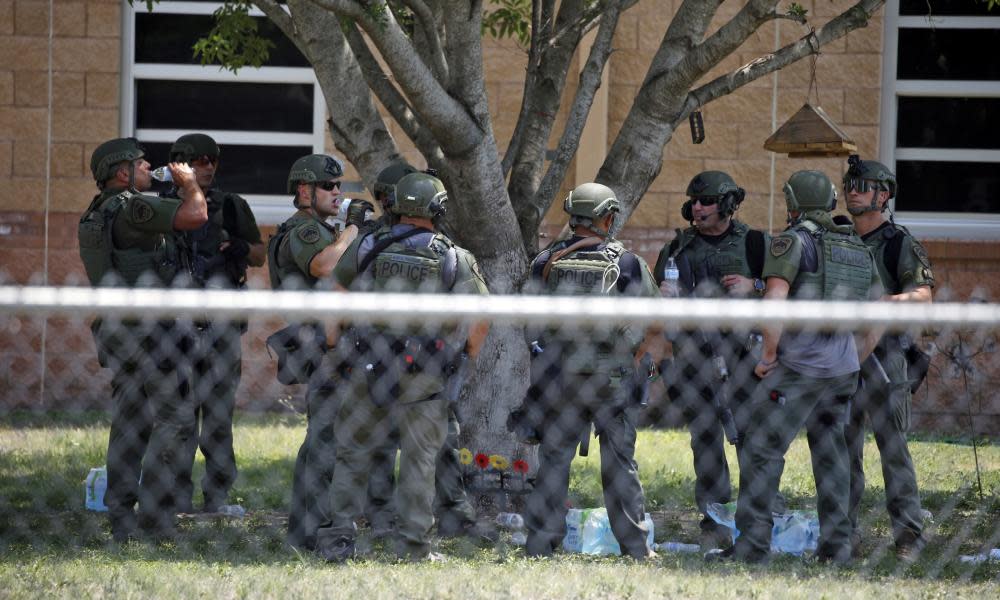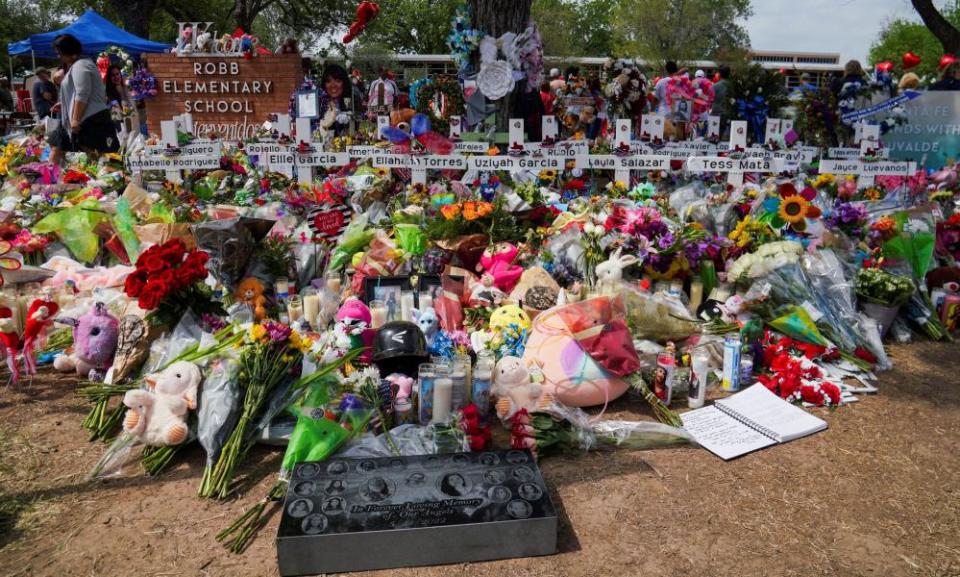‘They had no empathy’: for gun violence survivors, police response can be retraumatizing

For Americans who have lost family members to gun violence, the scene outside Robb elementary school in Uvalde, Texas, was all too familiar. The yellow caution tape. The distraught parents shouting at law enforcement officials and begging them for action or answers. And the officers’ response: reports and footage of relatives being restrained and allegations that some parents were even handcuffed or Tasered.
Related: Grim body count unlikely to be enough for Republicans to act on gun reform
“They had no empathy,” Yvonne Trice, an activist from California whose son was killed in 2015, said of the police treatment of relatives in Uvalde.
For Trice, the images from Texas brought back painful memories. She recalled getting no answer when she asked police officers at the scene of her son’s murder if they could cover up his body, so her son, Monte Russell, would not be left lying on the street. When her niece fell to the ground, overcome with grief, “they were just standing there looking at her”, Trice said.
It’s common for parents to respond rapidly to the scene of a shooting, as the parents in Uvalde did, said Jessica Pizzano, the director of victim services at Survivors of Homicide, based in Connecticut. Particularly because of social media, parents of people who have been shot can find out about the shooting quickly, and even “have a video of their child being shot”. But once they rush to the scene of the shooting, “they’re stuck behind the police line and no one will tell them anything.”
While the scale of the response in Uvalde was very different, the officers outside the school faced some of the same challenges as officers at the scene of a more ordinary homicide, said Roberto Villaseñor, a former police chief in Tucson, Arizona. Relatives often show up at homicide scenes, “frantic for news updates”, even as officers are trying to preserve the scene and collect evidence.
“Cops, unfortunately, have been put in the position of being social workers and almost mental health first aid providers, because there’s no one else,” Villaseñor said.
To address this problem, Pizzano and Villaseñor said, some police departments across the country have explored bringing social workers or other community outreach workers along with them, in order to provide someone who can assist family members and explain the way police are responding.
Cops have been put in the position of being social workers and mental health first aid providers, because there’s no one else
Roberto Villaseñor
DeWanda Stewart-Joseph, a community activist from Richmond, California, said she frequently responds to shooting scenes herself to comfort survivors and provide support in situations that can often be tense. It’s part of her mission to improve communication between survivors and police in her majority Black and Latino town.
Stewart-Joseph said she understood how police officers at a chaotic shooting scene, like the one in Uvalde, might default to trying to control the situation through force, by restraining parents and trying to “secure the area”.
“Not even understanding how to relate to people in traumatic circumstances like that can be devastating,” she said. “It’s like, in that instant, that’s all they knew how to do.”
While she has empathy for the trauma police officers experience as part of their jobs, Stewart-Joseph said, she also believes that when officers react with force to people in need of their help, it can cause lasting damage.
And for many gun violence survivors, the lack of care from police and other officials at the shooting scene is only the beginning, Stewart-Joseph said. “The legal system, the judicial system, can retraumatize people based on how the family is received,” she said.
Pizzano, the victims’ advocate from Connecticut, said that she often has to prepare survivors for the reality that many homicide detectives will stop calling them once an investigation stalls, and it may be a struggle to reach them at all. Detectives’ own discomfort with offering bad news or bad feelings about not solving a case may play a role in their reluctance to call, but that does a disservice to survivors, who sometimes simply want to be heard.

‘Can you give us dignity?’
As US gun homicides rose in 2020, the country’s rate of solving murders has plummeted to a historic low, with only about half of murders “cleared” nationwide, according to data from the FBI.
Experts say that the way police treat relatives of victims, both at a homicide scene and during the subsequent investigation, is crucial to getting the information they will need to solve the murders. But individuals affected by gun violence, particularly in communities of color, “described pervasive disregard by police in the aftermath of their loved ones’ shooting”, a 2020 Yale University study concluded.
Police are less likely to solve murders when the victims are Black, according to a Washington Post investigation, and failure to solve murders in some areas is so common that it has resulted in “pockets of impunity” for committing murder.
“For a lot of our families, the offender hasn’t even been caught yet. They’re still wandering around,” Pizzano said. “Imagine how terrifying that is, to know you could be at the grocery store across from the person who killed your child.”
There are other models for how to treat gun violence survivors. After the 2012 shooting at Sandy Hook elementary school, which left 26 children and adults dead, “each of the families was assigned a state trooper who was with them almost 24/7,” Pizzano said. The state troopers parked outside the families’ houses, “so they felt safe and felt supported”, something she said the families appreciated. That was a response “I had never seen before”, Pizzano said.
American police might learn from the British example of the “family liaison officer”, police employees tasked with communicating with bereaved families, the Yale University researchers suggested. The importance of family liaison officers in Britain was one response to police failures after the murder of Stephen Lawrence, a Black British teenager, in 1993, which prompted a wide-ranging inquiry into institutional racism in British policing.
Americans often view homicide through the lens of “good” and “bad” victims, with concern reserved for the murders of people perceived to be “innocent”, and activists have to counter with the argument that all homicide victims deserve to be treated with dignity and have their cases solved, Stewart-Joseph said.
Imagine how terrifying that is, to know you could be at the grocery store across from the person who killed your child
Jessica Pizzano
After Trice’s son was murdered in Pasadena in 2015, she said that she had met other mothers who felt that their children’s past behavior meant they could not speak out loudly for them after their deaths. Trice would not accept this: she spoke out forthrightly about her son’s incarceration and also about the new life he was building after his prison release and founded a support group, A Mother’s Voice, to help other survivors. Nearly seven years after Russell’s murder, his case has still not been solved, and Trice says the lack of updates from detectives throughout the entire process has suggested that his death was not a priority.
“We pay their salary thinking we’re going to get some kind of phone call,” Trice said. “What are we paying into? I’m serious. What are we paying into if we can’t even get you to call us back?”
Trice said she has been told that detectives are reluctant to call if they don’t have any new updates for the family members. But that does not matter to her: “I just need to hear your voice, to know that my son is important, not just to us, but to you, doing your job,” she said. “Can you give us dignity?”
In a statement, the Pasadena police department expressed sorrow that Trice “had to live through the tragic murder of her son”, but said that, both on the scene of Russell’s murder, and in investigating the case, the department’s officers had been professional and compassionate.
The department sent photographs of a police officer talking and holding hands with one “understandably distraught” woman at the scene of Russell’s murder, and said that officers had tried to provide information about what was happening, but “Unfortunately, many in the crowd were argumentative and unwilling to listen to our words.
“Despite what television may show, we do not utilize ‘sheets” or ‘blankets’ to cover a homicide victim. The ‘sheet’ is foreign to the crime scene (wasn’t there when crime occurred) and is considered a contaminate,” Lt Keith Gomez said in a statement.
Gomez said that homicide detectives had met with Trice and had “worked tirelessly for thousands of hours” to solve Russell’s murder, and that they had “identified major players involved in the conspiracy and pursued them years after the murder occurred”. Police had submitted the results of their investigation to the local district attorney’s office nearly a year ago, Gomez said, but, to their knowledge, the district attorney had not yet filed any charges.
Watching the police response in Uvalde, people who live outside the US “are probably wondering, ‘Why doesn’t the president do something?’” said Tracey Meares, a Yale University policing expert. But because policing in the US is controlled at the local level, across an estimated 18,000 different law enforcement agencies, there is not much Biden’s administration can do.
“Washington is not in charge of the Uvalde police,” Meares said. “It’s just not the way it works.”

